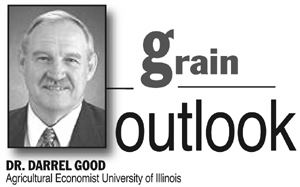|
Corn And Soybean Acreage

The debate about the likely size of the USDA’s final estimate of the 2014 U.S. average corn and soybean yields continues, with the market apparently anticipating that those estimates will exceed the August forecasts, particularly for corn. At the margin, the size of the crops will also be influenced by the magnitude of harvested acreage.
The first acreage issue is the magnitude of planted acreage and the second is the magnitude of harvested acreage. The current planted and harvested acreage forecasts are based on the June USDA surveys, adjusted for any new information revealed in the August crop production surveys. The August forecasts were unchanged from the June forecasts. History suggests that final acreage estimates will differ from current forecasts, with the direction and magnitude of those changes being the issue.
Since 1996, when agricultural policy changed to accommodate more planting flexibility, the final estimate of corn planted acreage ranged from 2.014 million acres less (2013) to 750,000 acres more than the June forecast. The difference exceeded one million acres in only four of the 18 years from 1996 through 2013. The average difference was a decline of 432,000 acres, statistically not different from zero. However, the final estimate was below the June forecast in 13 of the 18 years. The larger declines were in years of late planting, but not all late planted crops resulted in large declines from the June forecast to the final estimate. During that same time period, the final estimate of soybean planted acreage ranged from 1.464 million acres less (2010) to 1.185 million acres more (2008) than the June forecast. The difference exceeded one million acres in six of the 18 years. The average difference was a decline of 141,111 acres, statistically not different from zero. However, the final estimate was below the June forecast in 11 of the 18 years from 1996 through 2013. The difference between the June forecast and the final estimate of planted acreage during that period was not correlated to either the lateness of corn or soybean planting.
For the current year, a larger than average percentage of the corn acreage in the 18 major corn producing states was planted late (defined here as after May 20). Much of the late planting was in northern and eastern states. A late planted crop along with the historical tendency for the final estimate of planted acreage to be less than the June forecast suggest that the final estimate this year will likely be below the June forecast of 91.641 million acres. The average difference in the 13 previous years of a drop in acreage estimates from June to final was 690,000 acres, in a range of 28,000 to 2.014 million. The average excluding the large decline last year was 580,000 acres. A decline of 500, 000 to 700,000 acres would not be a surprise this year. The checkered pattern of historical differences between the June forecast and final estimate of planted acreage of soybeans provides little guidance for forming expectations this year. The tendency since 1996 for the final estimate to be less than the June forecast may influence expectations for acreage to be below the June forecast of 84.839 million acres. In those years since 1996 when the final estimate was less than the June forecast, the average difference was 705,800 acres, in a range of 32,000 to 1.464 million acres.
The USDA’s Farm Service Agency (FSA) released its first report of planted and prevented acreage on August 15. Estimates in that report are based on required acreage certification by those producers participating in federal commodity programs. The August report, however, provides little guidance for forming expectations about changes in acreage forecasts by the USDA’s National Agricultural Statistics Service (NASS) for two reasons. First, the FSA report reflects only acreage certifications to date. Those numbers will increase by an unknown amount in future reports. Last years’ experience suggests that the September estimates, and certainly the October estimates, will be very close to the final estimates. Second, the magnitude of prevented acreage that was already reflected in the NASS June acreage forecast is not known.
From 1996 through 2013, the difference between planted acreage of corn and acreage harvested for grain averaged 7.464 million acres, in a range of 6.585 million (1996) to 9.78 million (2012). That difference has increased by a very modest amount over time as total corn acreage has increased, and tends to vary by the nature of the growing season. The large difference in 2012, for example, reflected widespread dry conditions with more acreage harvested for silage or abandoned. Based on the USDA’s June surveys, the difference between planted and harvested acreage this year is forecast at 7.802 million acres, about equal to the trend value. The actual difference should be within a few thousand acres of the forecast.
For soybeans, the difference between planted and harvested acreage averaged 1.095 million acres, in a range of 595,000 acres (2007) to 1.858 million acres (2000). The difference has trended lower over time. Based on the USDA’s June surveys, the difference between planted and harvested acreage this is forecast at 781,000 acres. That is nearly 200, 000 acres less than the trend value for this year. Based on reports of more than the normal amount of acreage lost to flooding, the actual difference may be closer to trend value.
While average yield will be the driver of the size of the 2014 U.S. corn and soybean crops, harvested acreage may be marginally less for both crops than currently forecast. ∆
DR. DARREL GOOD: Agricultural Economist, University of Illinois
|
|